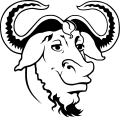 | |
| Developer(s) | The GNU Project |
|---|---|
| Stable release | |
| Repository | |
| Operating system | Unix-like |
| License | GPL-3.0-or-later |
| Website | www |
Mtools is a free software collection of utilities to allow a Unix operating system to manipulate files on an MS-DOS file system, typically a floppy disk or floppy disk image. [2] [3]
Contents
The mtools are part of the GNU Project and are released under the GNU General Public License (GPL-3.0-or-later).